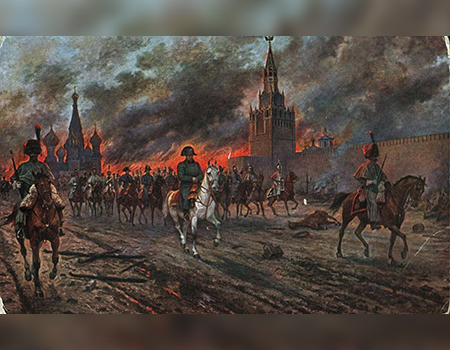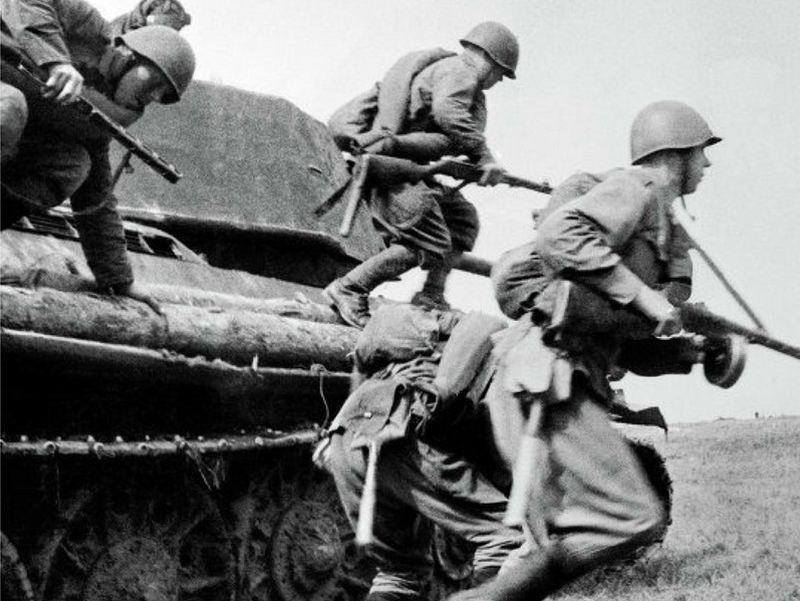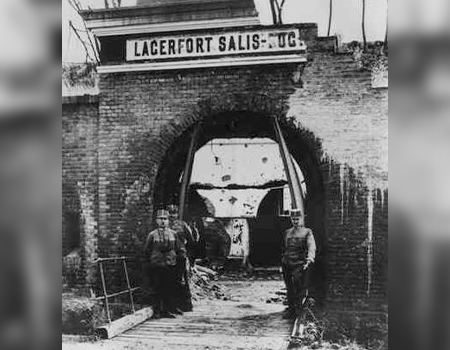
-On this Day in History –
September 16th 1914 – World War I: The Siege of Przemyśl (present-day Poland) begins.
The Siege of Przemyśl was the longest siege of the First World War, and a crushing defeat for Austria-Hungary against Russian attackers. Przemyśl (German: Premissel) was a fortress town on the River San and a Galician stronghold. The investment of Przemyśl began on 16 September 1914, and was briefly suspended on 11 October, due to an Austro-Hungarian offensive. The siege resumed again on 9 November, and the Austro-Hungarian garrison surrendered on 22 March 1915, after holding out for a total of 133 days.
Background
In August 1914, Russian armies moved against both German East Prussia and Austria-Hungary’s largest province of Eastern Galicia, straddling the present-day Poland/Ukraine border. Its advance into Germany was soon repulsed but its Galician campaign was more successful. General Nikolai Ivanov overwhelmed the Austro-Hungarian forces under Conrad von Hötzendorf during the Battle of Galicia, and the whole Austrian front fell back over 160 kilometres (100 mi) to the Carpathian Mountains. The fortress at Przemyśl was the only Austrian post that held out and by 28 September, was completely behind Russian lines. The Russians were now in a position to threaten the German industrial region of Silesia, making the defense of Przemyśl of importance to the Germans as well as the Austro-Hungarians.
50 kilometres (30 mi) of new trenches were dug and 1,000 km (650 mi) of barbed wire were used to make seven new lines of defence around the perimeter of the town. Inside the fortress a military garrison of 127,000, as well as 18,000 civilians, were surrounded by six Russian divisions. Przemyśl reflected the nature of the Austro-Hungarian Empire – orders of the day had to be issued in fifteen languages. Austrians, Poles, Jews and Ukrainians were together in the besieged town, that was hit constantly with artillery fire, and as the toll of dead and sick and wounded rose, and starvation threatened, so did mutual distrust and racial tension.
-
 PPSH-41 SUBMACHINE GUN, SOVIET UNION 1941€342,00 +VAT
PPSH-41 SUBMACHINE GUN, SOVIET UNION 1941€342,00 +VAT -
 LUGER P08 ARTILLERY MODEL, GERMANY 1898€189,00 +VAT
LUGER P08 ARTILLERY MODEL, GERMANY 1898€189,00 +VAT -
 C96 PISTOL with Wooden Stock (GERMANY 1896)€256,20 +VAT
C96 PISTOL with Wooden Stock (GERMANY 1896)€256,20 +VAT
First siege
On 24 September, General Radko Dimitriev, commander of the Russian Third Army began the siege of the fortress. Dimitriev was without sufficient siege artillery when he began the investment and instead of waiting for the Russian high command to send him the artillery pieces, Dimitriev ordered a full-scale assault on the fortress before an Austrian relief force could be sent. For three days the Russians attacked and accomplished nothing at the cost of 40,000 casualties. While this was under way General Paul von Hindenburg launched an offensive against Warsaw in the north. In conjunction with the German attack on Warsaw, General Svetozar Boroevic von Bojna led a relief force towards Przemyśl. On 11 October, Dimitriev lifted the siege and withdrew across the San River. Conrad von Hötzendorf had hopes that a combined assault from Boroevic’s army and the Przemyśl garrison would inflict a severe blow on the Russians.
A month and a half on from the time when the Russians encircled the town, German troops helped the Habsburg troops to break the encirclement. Civilians were ordered to leave at once – in part to relieve the severe food shortage.
Second siege
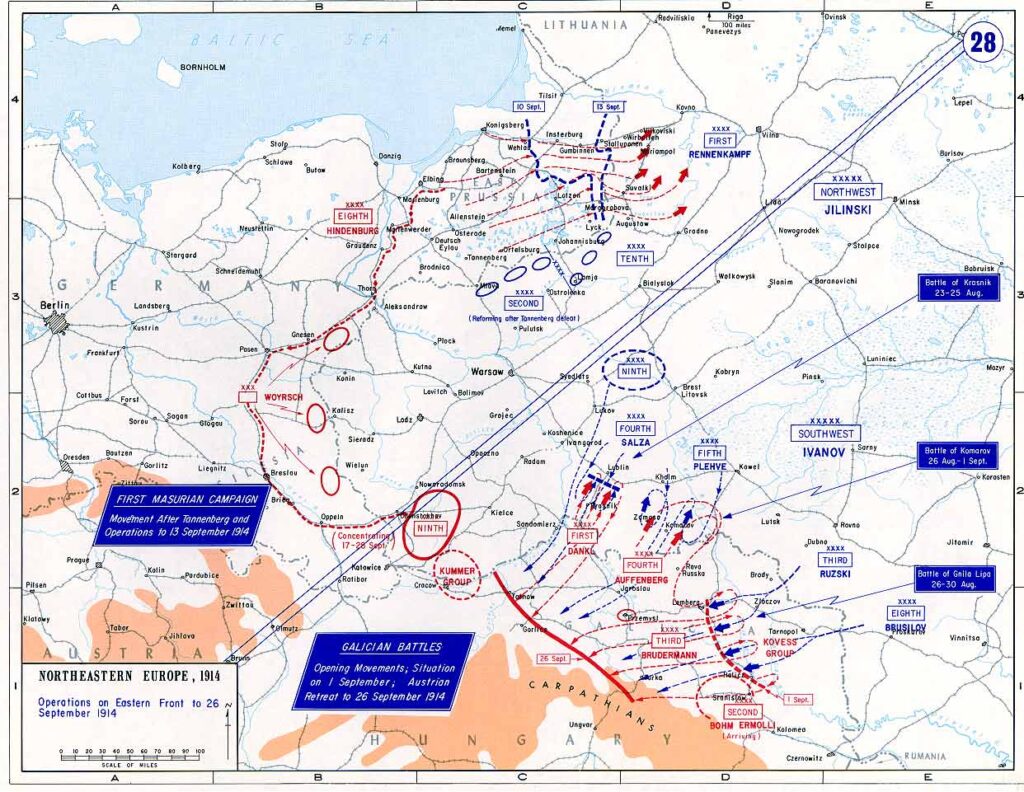
photo by: Department of Military Art and Engineering, at the U.S. Military Academy (West Point)
By 31 October, Hindenburg had been defeated at the Battle of the Vistula River and withdrew from his assault on Warsaw. This caused Boroevic to pull back from the River San line, and abandon von Hötzendorf’s proposed offensive against Russia. On November 9 the Russians resumed the siege of Przemyśl. Radko Dimitriev‘s force was withdrawn from the Przemyśl sector and moved north. The Russian Eleventh Army under General Andrei Nikolaevich Selivanov took up the siege operations. Selivanov did not order any frontal assaults as Dimitriev had, and instead settled to starve the garrison into submission. By mid-December 1914, the Russians were pounding the fortress with ceaseless artillery fire seeking to compel the town’s surrender. During the winter 1914–1915 the Habsburg armies continued to fight their way to the fortress. Months of fighting resulted in great losses, largely from frostbite and disease, but relieving forces failed to reach the garrison at Przemysl.
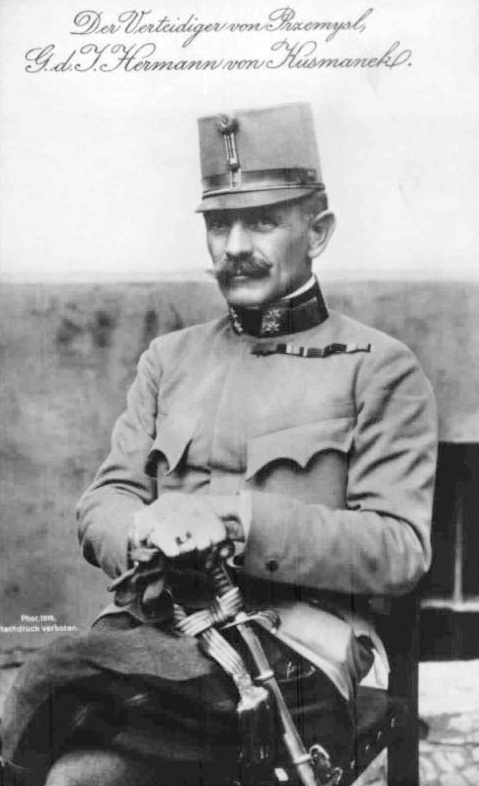
In February 1915, Boroevic led another relief effort towards Przemyśl. By the end of February, all relief efforts having been defeated von Hötzendorf informed Hermann Kusmanek von Burgneustädten that no further efforts would be made. Selivanov was given sufficient artillery to reduce the fortress. The Russians overran the northern defenses on 13 March. An improvised line of defense held up the Russian attacks long enough for Kusmanek to destroy anything left in the city that could be of use to the Russians once captured. On March 19 Kusmanek ordered an attempt to break out but his sallies were repulsed and he was forced to retreat back into the city. With nothing useful left within the city, Kusmanek had no choice but to surrender. On 22 March, the remaining garrison of 117,000 surrendered to the Russians. Among the captured were nine generals, ninety-three senior staff officers, and 2500 other officers.
Results
The fall of Przemyśl led many to believe that Russia would now launch a major offensive into Hungary. This anticipated offensive never came, but the loss of Przemyśl was a serious blow to Austro-Hungarian morale. A further blow to Austria-Hungary was the fact that Przemyśl was only supposed to be garrisoned by 50,000, yet over 110,000 Austro-Hungarians surrendered with the fortress, a much more significant loss. The Russians held Przemyśl until the summer of 1915 when the Gorlice-Tarnow Offensive pushed back the Russian front in Galicia. Przemysl stayed in Austro-Hungarian hands until October 1918, at which point Eastern Galicia left the Austro-Hungarian Empire and became part of the newly created independent state of Poland. The Austro-Hungarian army never recovered from its losses in the winter of 1914–1915 and the Habsburgs would rely henceforth on German assistance both in their sector of the Eastern Front and in the Balkans.

Meanwhile Austro-Hungarian attempts to relieve the fortress ended catastrophically as the poorly supplied and outnumbered imperial forces attempted offensive after offensive through the Carpathian Mountains. Casualties for January to April 1915, in the Carpathians, were officially reported as 800,000, mostly due to weather and disease rather than combat. Russian casualties were nearly as high, but easier to replace, and balanced out more by the surrender of 117,000 Austro-Hungarian troops at the end of the siege. All told, the siege and the attempts to relieve it cost the Austro-Hungarian army over a million casualties and inflicted on it significant damage from which it would never recover.
SOURCE
Wikipedia





